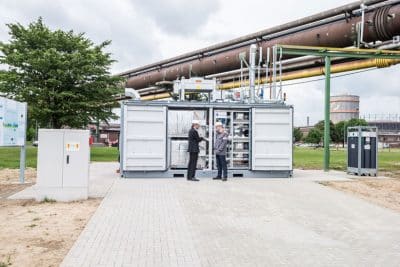Even if renewable hydrogen is not yet economically viable, there have been some demonstration projects to test its general suitability outside simulated environments. One of these research endeavors is the EU’s GrInHy, in which a consortium made up of eight companies based in the Czech Republic, Germany, Italy, Finland and Spain have been working together to make an RSOC, that is, a reversible solid oxide electrolyzer, part of the manufacturing process at German steelmaker Salzgitter Flachstahl.
GrInHy is short for Green Industrial Hydrogen via Reversible High-Temperature Electrolysis. Launched in August 2016 and funded by the EU’s Horizon 2020 program, the project has been focused on testing solid oxide electrolyzer cells, or SOECs, for renewable hydrogen production in a real-life steelworks environment.
To this end, a high-temperature electrolyzer was installed in Salzgitter in June 2017 and brought online in October. The unit called SynLink SL 40 is a product by Sunfire, a manufacturer founded in Dresden, Germany, in 2010. It has 150-kilowatt of input and can operate in reverse. This means that the same unit can function not only as an electrolyzer to produce hydrogen but also as a fuel cell to reconvert the gas into electricity.
Steel and carbon dioxide production
In 2016, German steelmakers produced more than 42 million tons of raw steel. One ton releases an average of 1.34 tons of carbon dioxide, so that steel production caused about one-third of all carbon dioxide emissions in the German industrial sector and around 10 percent in all of Germany.
…
Comparable Sunfire ROSC systems were shipped to Boeing in the United States and a Total station in Karlsruhe, Germany, where it supplies the hydrogen pump (see H2-international, October 2017).
SALCOS®
Like ArcelorMittal (see How Feasible Is a Zero-Carbon Steel Industry?), Salzgitter Flachstahl employs a direct reduction process. The medium-term goal is to replace coke with natural gas and hydrogen to reduce carbon dioxide emissions. The steelmaker, which hails from the German state of Lower Saxony, has initiated a string of projects, collectively named SALCOS – Salzgitter Low CO2 Steelmaking. It will report on the progress made with GrInHy at the European SOFC and SOE Forum, which will take place July 3 through 6, 2018, in Lucerne, Switzerland.
Plant in Linz to come online in late 2018
Austria has seen similar levels of commitment. In April, the H2Future business consortium began constructing a system at voestalpine, a Linz-based manufacturer of industrial goods (see Hydrogen to Replace Coal). The company stated that the 6-megawatt Siemens-brand electrolyzer, planned to come online late this year, would become the world’s largest electrolysis plant to produce green hydrogen for steelmaking. The aim, according to Wolfgang Eder, chairman and chief executive of voestalpine, was to find genuine breakthrough technologies that could be used at large scale in around two decades’ time. The EUR 18 million trial to produce 1,200 cubic meters of hydrogen per hour is scheduled to start in early 2019 and run for two years.
“If coal is no longer an option to consider, then it has to be hydrogen. […] We offer the government a system for widescale use that can help reduce emissions.”
Heinz Jörg Fuhrmann, chief executive and chairman of Salzgitter Group
…
Toward renewable steelmaking
In June 2017, LKAB, SSAB and Vattenfall, three Swedish businesses operating in the mining, steel and energy industries, formed a joint venture called HYBRIT – The Way to Fossil-Free Steel. The corporations have since been sharing equal parts in the work to replace coke and coal with hydrogen. Jan Moström, president and chief executive of LKAB, said, “Forming a joint venture to develop HYBRIT is proof of our conviction that it is possible to create a supply chain, from mines to steelworks, without the use of fossil fuels. If we’re successful, we will achieve a technological breakthrough, a global contribution to mitigate much of the impact of climate change.”
…
Hydrogen for sintering
HyGear, a Dutch electrolyzer manufacturer, is also beginning to shift its attention to the metal industry. In mid-April 2018, it signed a long-term deal to supply hydrogen to a globally operating metal producer, which intends to make large-scale use of the gas for sintering. Plans are to install a HyGear Hy.GEN® electrolyzer to guarantee base supply and meet short-term peaks in demand through fuel trailers.
…



























Reading this complicated joint effort there is small wonder that we have taken years to get this far.
Hydrogen Production on Demand On Board the EV is possible and covered by US Patents The problem being it does not work with Fuel Cells as the movement of the vehicle causes Air Impurities which I am sure you will be aware blocks the cell from working.
There is also my concept for a Hydrogen Combustion Internal Steam Turbine-generator. Combustion would not be affected.
I have just withdrawn from the intended JV which was in collaboration with University of Nottingham since the the JV has not been confirmed and was not likely to be since owner of the IP was not joining in, it was in fact just a VP of his company.
The very roughly projected costs of development and the eventual H2 Zero emission Power Pack would bring about Affordable Zero Emissions EV. eg replace petrol generator in BMW i3 with Ezi H2 HyPulJet Turbine generator and get rid of most of battery and the H2 version could have a lower price than the petrol version.
There are other implications however these are easy to bring into play.
The greatest benefit being that there is no need for Gigga battery factories or increased generating capacity, Charge points or H2 filling stations where the costs of these will means Zero EVs with cost a fortune.
Please feel free to contact me perhaps this could be developed to the benefit of the planet.
Even if it means developing the ACE II unit under Open Source IP and then taking a licence from the US company it will be worthwhile at lower costs than anything seen at present.